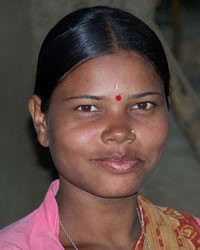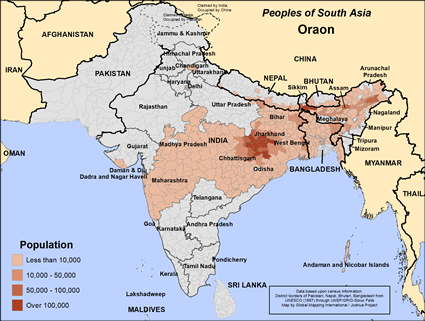The Dhangar Oraon people of Nepal, whose native language is Kurux, live in the jungle plains of southeastern Nepal. They associate themselves with the greater Oraon community, who live primarily in India and Bangladesh. The Dhangar Oraon of Nepal migrated to their current homeland from India in the mid-1800s, but they have retained a strong connection to their culture and religion, and still speak their Kurux language. Although southern Nepal is an ethnically diverse area, Dhangar Oraon people tend to live in homogenous neighborhoods and maintain a strong community connection.
Dhangar Oraon home styles vary by area within Nepal, but are typically made of bamboo, mud, and cow dung, with thatched roofs.
Most Dhangar Oraon people in Nepal are farmers by occupation, but many do not own their own land. Despite living in rural areas, even the most remote settlements have easy access to major roads, larger towns, and cities. This allows for families to supplement farming income with other means of employment such as tailoring, metalworking, carpentry, technical jobs, office work and entrepreneurship.
Because they have maintained their culture and a strong family structure, Dhangar Oraon people have a strong internal support network. Many, however, do not own their own land or have the financial means to access higher education, healthcare, and other amenities.
Dhangar Oraon people tend to live in homogenous neighborhoods within diverse areas, and therefore are highly multilingual meaning that most of the population speaks 3 or more languages such as Maithili, Tharu, Bhojpuri, Sadri, and Tamang in addition to Nepali. Although school is taught in Nepali children still speak Kurux with friends and in their homes.
There are few Dhangar Oraon Christians in Nepal and only one known Dhangar Oraon church. Most people are very dedicated to their own religion.
The Dhangar Oraon people practice a unique nature-based religion which is centered around the Karam Festival, in which they worship the branches of the Karam tree. The festival lasts two days and consists of fasting, song and dance, and food offerings which are then eaten at the end of the day to break the fast. Their religion has other festivals throughout the year. Many Dhangar Oraon people also celebrate Hindu festivals, showing influence from Hinduism, the dominant religion in Nepal.
There is at least one church with Dhangar Oraon members in Nepal, and possibly one or two Indian Dhangar Oraon missionaries working in Nepal, but this is not yet confirmed.
There is one existing Bible in the Kurux language which is from a dialect in India. This version has been banned in India, but two other translations were in progress as of 2018. Sadly, many of the speakers in Nepal may have some difficulty understanding the vocabulary, as the Nepali dialect has some lexical differences from the Indian dialect. Kurux speakers in Nepal do not seem to be aware of the vast amounts of written literature available in the Kurux language (all based out of India). Kurux speakers in Nepal would benefit from learning to read their own language in an alphabet they already know. There are many Kurux resources available from India including hymn books, literature, sound recordings and the Jesus film, although some are outdated.
The Uranw community in India has a large Christian population and has made some efforts to connect with Kurux speakers in Nepal and northern Bihar. Cross-border connection and collaboration has the potential to reach many people with the gospel.
Pray for a spiritual hunger that will overcome community pressure for conformity.
Pray for loving and dedicated workers.
Pray for Dhangar Oraon disciples to make more disciples.
Scripture Prayers for the Oraon, Dhangar in Nepal.
| Profile Source: Joshua Project |












